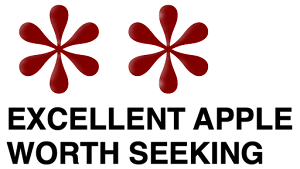
|
My sample of this antique apple comes not from the St. Lawrence valley, where it may have originated, but from western Washington.
Red vertical stripes, some deep and saturated, radiate from the stem well of this visually striking apple.
 They contrast with Saint Lawrence's otherwise pale yellow-green peel. Many
small red flecks mix in with darker lenticel dots.
They contrast with Saint Lawrence's otherwise pale yellow-green peel. Many
small red flecks mix in with darker lenticel dots.
The apple has a classical shape, somewhat tapered and ribbed, and a bit broad. The grower urges me to skip the review if mine is a "mealy mush," but it's pretty firm in hand.
Proof of pudding
The texture is substantial and good, though with the decidedly subdued crunch one sometimes finds in antique varieties. It leaves pleasant, wholesome sensations in its wake in mouth and gut.
Cue the Research Department
Please excuse me while I fuss, briefly, over the fact that nobody sees fit to explain how they know these things.
On the other hand, some folks in Maine included Saint Lawrence in some DNA testing they commissioned, and determined that one parent is Fameuse, ancestor of McIntosh.
Fameuse is also known as Snow.
(I described the gene-testing last March. Some other results are in Jacob Mentlik's summary published by the Maine Organic Farmers Association in 2021.)
And there is a wealth of historical data—all sourced—in Beach's Apples of New York (2:192)(1909).
Beach says St L used to be grown on both sides of the St Lawrence River and Champlain valley, and may have originated south of the Canadian border.
And thanks!
I still find apples on my own to add to my opinionated catalog. Nonetheless, that search necessarily grows harder the more I succeed.
So, many thanks to growers who like to share!

Comments
Post a Comment
Join the conversation! We'd love to know what you think.